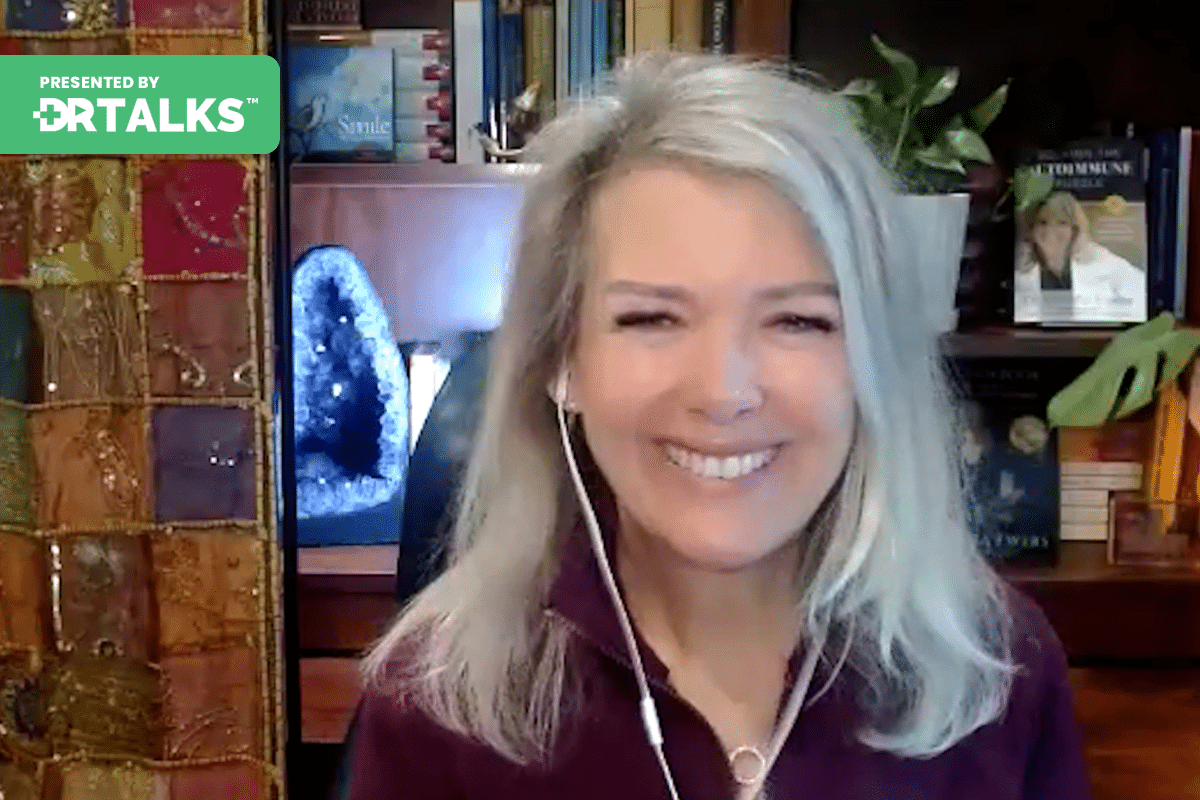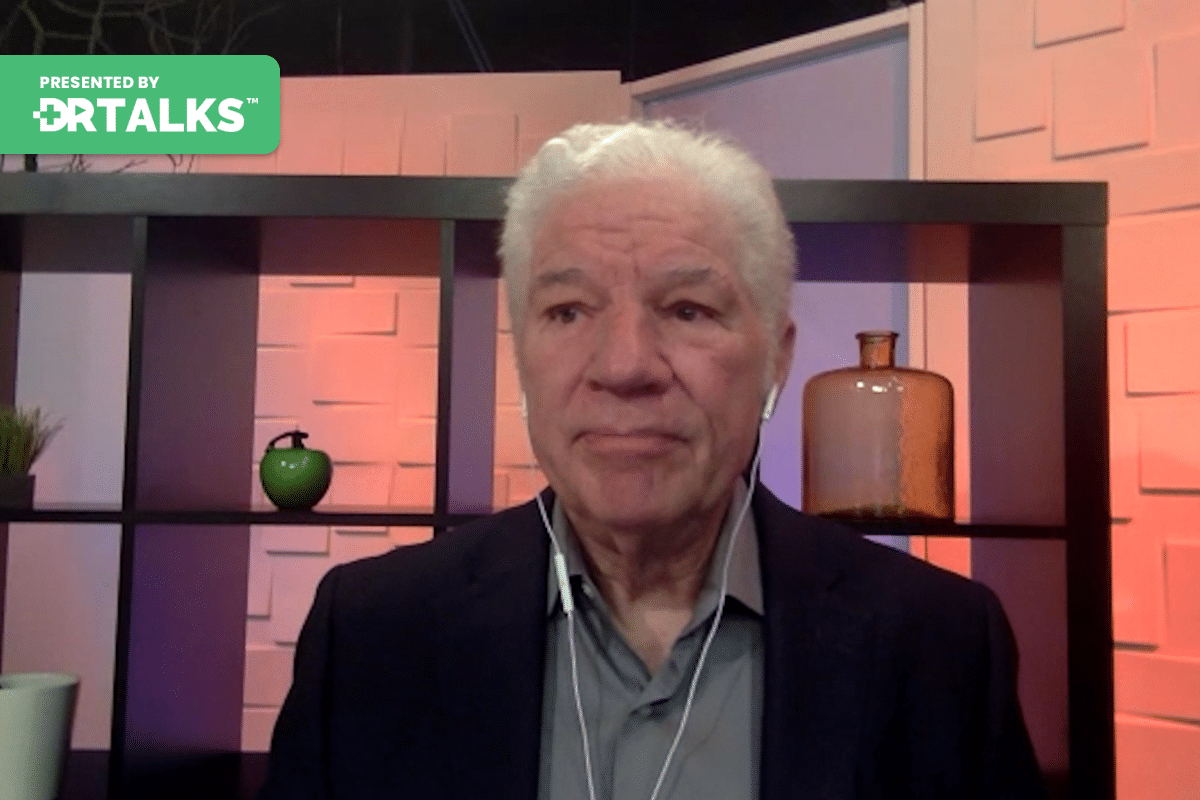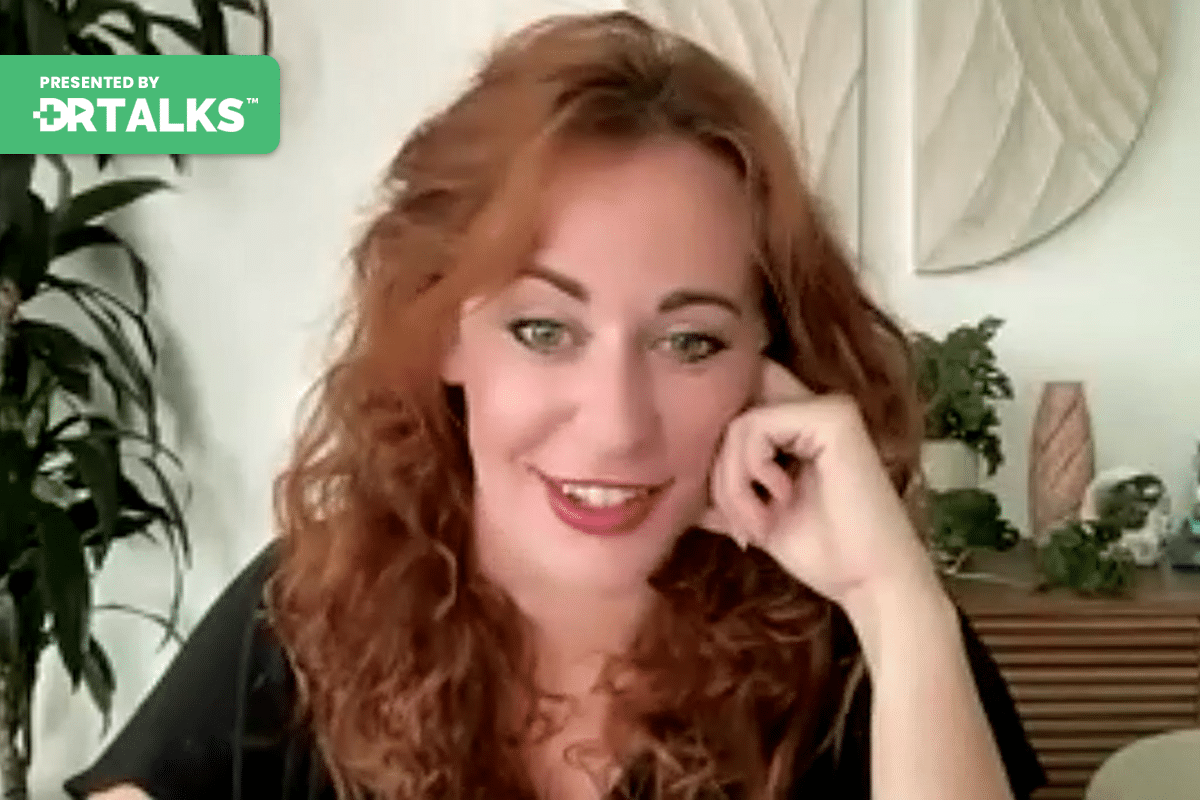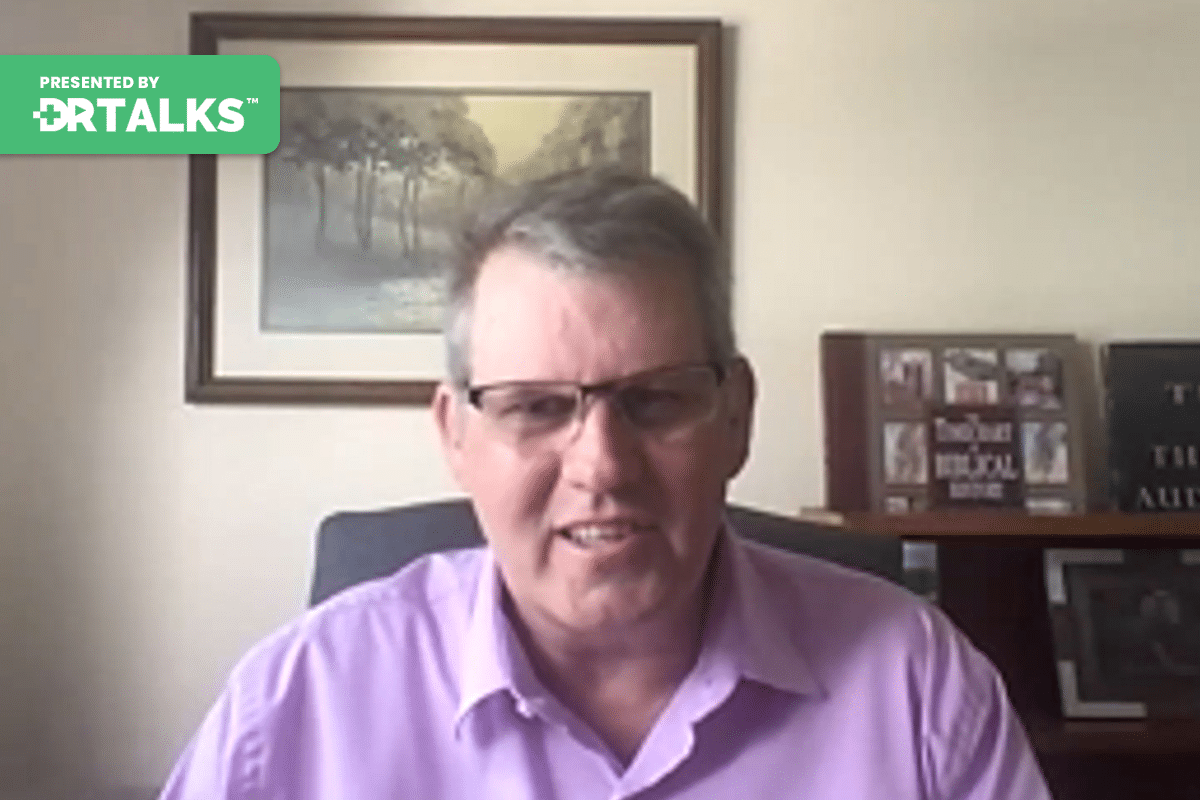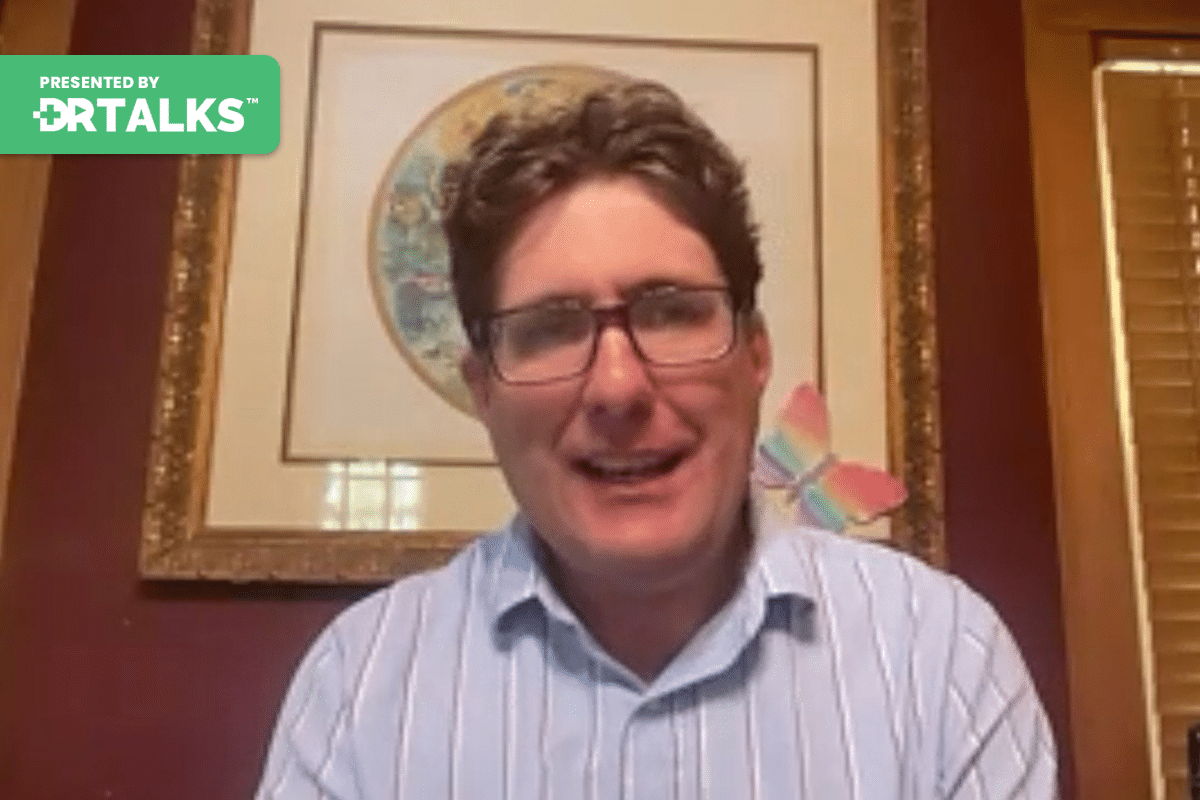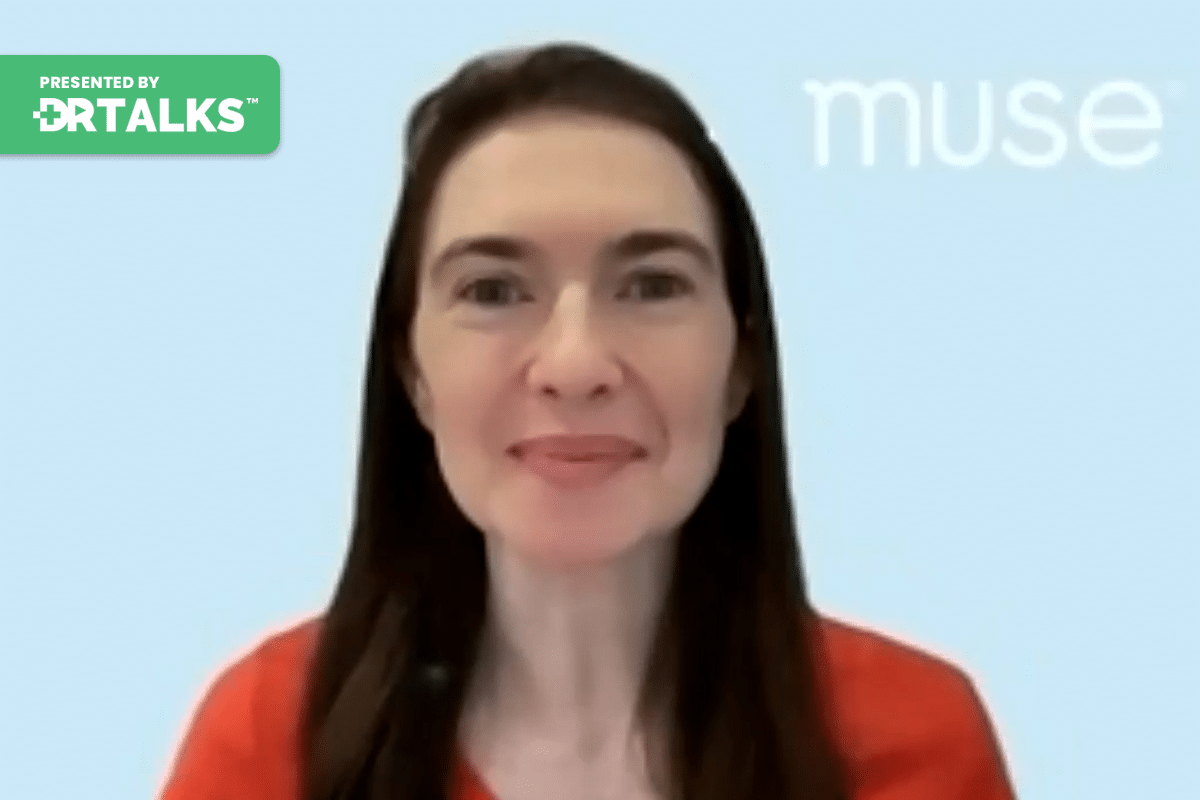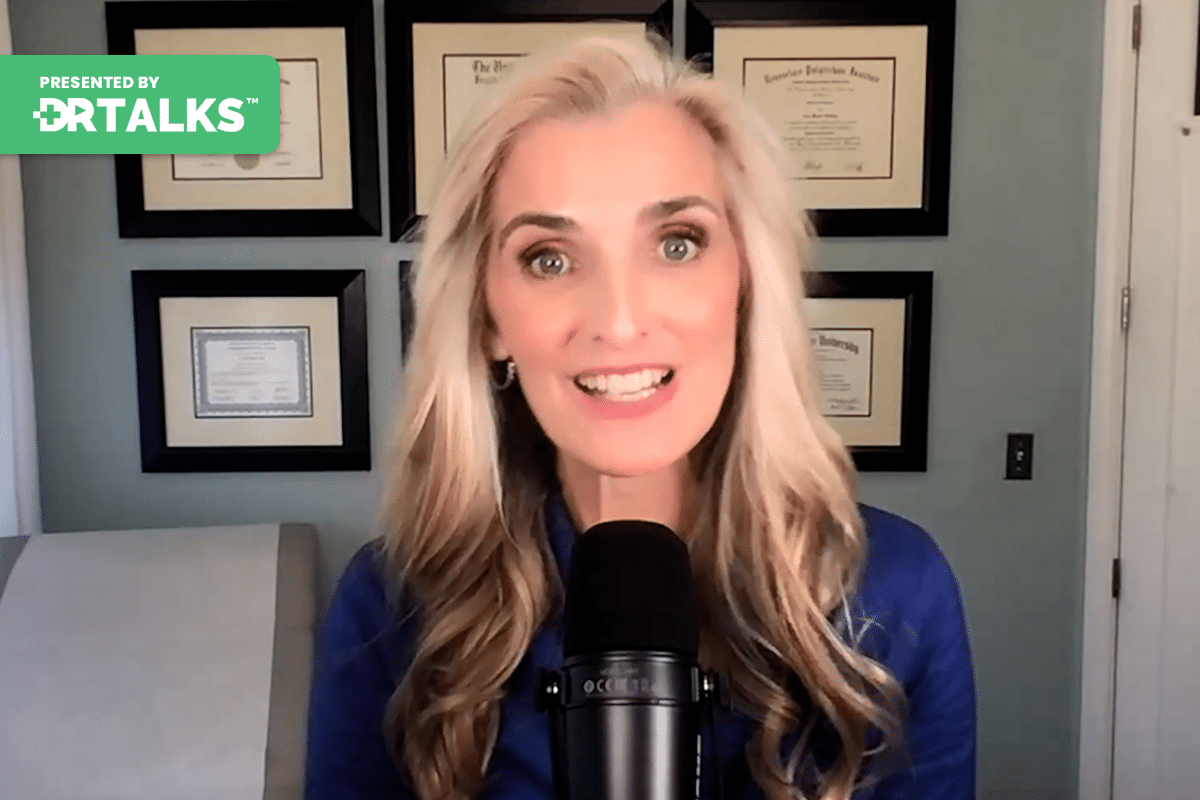Join the discussion below
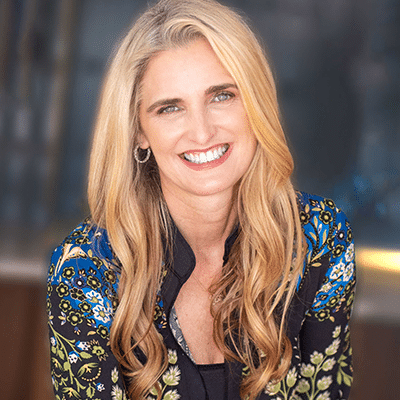
Dr. Ann Shippy is Board Certified in Internal Medicine and Certified in Functional Medicine. She operates a successful private practice in Austin, TX where she is known for her compassionate, attentive, and tireless approach to caring for her patients. She has gained a considerable reputation for successfully diagnosing and treating... Read More
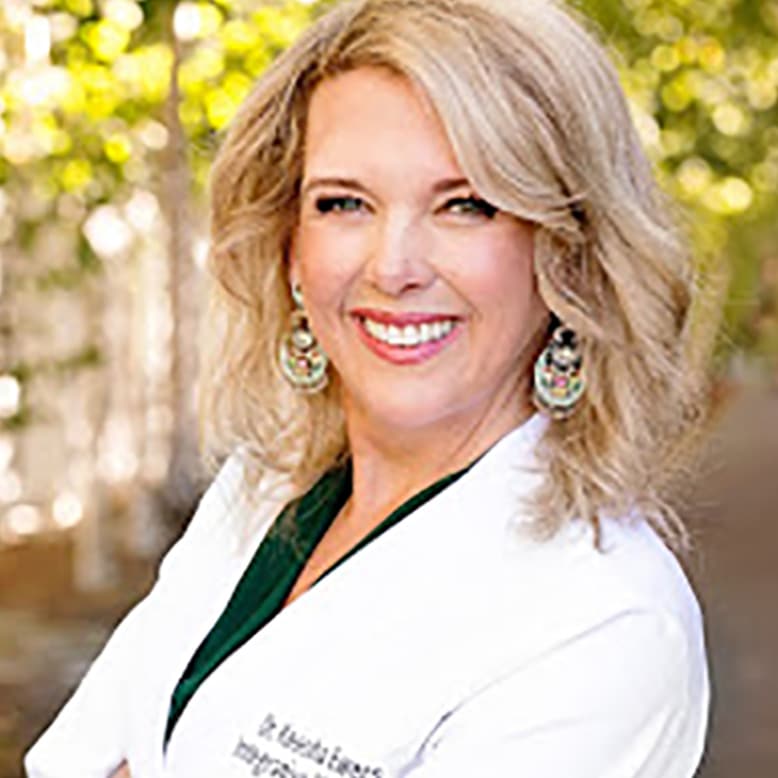
Keesha Ewers, PhD, ARNP-FNP-C, AAP, IFM-C
Dr. Keesha Ewers is an integrative medicine expert, Doctor of Sexology, Family Practice ARNP, Psychotherapist, herbalist, is board certified in functional medicine and Ayurvedic medicine, and is the founder and medical director of the Academy for Integrative Medicine Health Coach Certification Program. Dr. Keesha has been in the medical field... Read More
- Understand how emotional reactivity can influence physical health
- Learn strategies to heal emotional reactivity and break physical patterns
- Discover the role of mindset in healing and well-being
- This video is part of the Mold, Mycotoxin, and Chronic Illness Summit
Related Topics
Accutane, Alternative Cure, Antibiotics, Autoimmunity, Ayurvedic Medicine, Chronic Illnesses, Chronic Inflammation, Dietary Changes, Emotional Reactivity, Family History, Immune System, Meditation, Microbiome, Mold Exposure, Perception, Physical Patterns, Respiratory Problems, Rheumatoid Arthritis, Secondhand Smoke, Sexual Abuse, Skillful Response, YogaAnn Shippy, MD
Welcome to another episode of Mold, Mycotoxin, and Chronic Illness Summit. I’m your host, Dr. Ann Shippy, and today I get to interview Keesha Ewers she’s got one of the most interesting, diverse backgrounds of anybody I know, even in the functional medicine world. She’s a doctor of sexology, a nurse practitioner, Ayurvedic. She’s done MAPS Treatment Training. She’s a doula of conscious dying. All of this and more has prepared her for the world of trauma, which we’re starting to understand from research is playing such an important part for all of us who are affected by chronic illness or environmental toxicity. Do you want to elaborate a little bit more on that?
Keesha Ewers, PhD, ARNP-FNP-C, AAP, IFM-C
Sure. When we started talking about how this is connected, I was talking about how oftentimes we head toward the signpost that I think is sort of like the low-hanging fruit on the tree where we’ll say, “Okay, let’s look at your microbiome.” That’s a perfectly accurate thing to do. But then there’s a point, and this is where a lot of my patients find me: when they’ve spent a lot of money on protocols, supplements, and dietary changes that worked with a lot of people, they’re still not better, and they’re very angry and frustrated. It’s the angry, frustrated reactivity to life that made me programmed early in life in response to early childhood events. You know what our genetics are, how our program is genetic, and then also the nurture part of it in terms of what our expectations of life are, our perceptions, and the driving force behind a lot of chronic illnesses. If we’re reactive in the mind, we become reactive in our bodies. According to Ayurvedic medicine, this 5000-year-old sister science of yoga from India, Right?
Ann Shippy, MD
I loved that too. It helped me way back, even before I went to medical school to heal.
Keesha Ewers, PhD, ARNP-FNP-C, AAP, IFM-C
Same here. They said we are not all the same. There are different ways we’re supposed to feed ourselves with water, sleep, or take ourselves for a walk. Because according to seasonal changes and age-related changes, all of these things are not set in stone. Here’s a protocol to follow for every single person: I think we get very angry and frustrated if we read something in a book, read a blog, or work with a functional medicine provider and then have the expectation that that one thing is going to take care of it, when in fact we’re very complex beings and we each have our unique genetics. There are no two the same. We have our unique genetics. We have our way that we hold on to our perceptions from childhood and of life and the way that we lived it, and that our programs our the nervous system and how we respond to life. Going from childhood to elderhood, there’s a place where we’re supposed to move from reactivity to skillful response. I think that a lot of the work that I do with my patients involves moving them away from reactivity. The body reacts against pollen, mold, viruses, bacteria, and pathogens of all sorts, including parasites, because the mind is now perceiving everything differently, so there’s a gap between reactivity and response. That takes a lot of skillful training for ourselves. We have to train our minds about how we respond to the world. If the child part of us is still reacting, we have certain expectations about the way things should be. Yes, not feeling safe, like safety is always first. If you don’t feel safe in any kind of environment or in your mind, then it doesn’t matter how many supplements you take. It’s not going to work.
Ann Shippy, MD
Well, because we are always in survival mode. Healing mode rather than letting your body say, I’m so with you on this. It’s a foundational principle. A lot of times we kind of bury whatever it was, or we’re not even aware of what our family programming was until somebody helps us to see it or mirror it. I love that we’re going to get to explore this topic more. It’s so awesome. I remember from years ago, and I think it’ll help our listeners to know that you can understand what they’re going through. I know you’ve gone through some mold, so would you be up to telling?
Keesha Ewers, PhD, ARNP-FNP-C, AAP, IFM-C
Absolutely.
Ann Shippy, MD
That story so people can know that you can go from pretty tough things to feeling as amazing as you do and that you look like you. I haven’t seen you in a couple of years, and you look better than ever.
Keesha Ewers, PhD, ARNP-FNP-C, AAP, IFM-C
Thank you. This is such a wonderful opportunity, and I thank you for providing it and asking that question because, again, we’re all so different, and my journey will be different from everyone else’s. But I always say everyone who lends themselves to talking about these subjects, like us, has a story. I’m no exception. Yes. I grew up as a Navy brat living in 21 places by the time I was 14 in a lot of very moldy environments in the South Key West, Florida, all the Southern States in Japan, off base where we had to Tommy mats and rice paper walls and things like that, which turns out those are great. Yes, but a lot of stuff can get into that. There was a lot of mold and chemicals from the naval air station. My dad was out to sea a lot, but we lived on the bases, and there was a lot of jet fuel. I was a third-generation photographer and still am. I would have my hands on all the chemicals because I didn’t know so much. This was my upbringing. My dad was a smoker, so there was a lot of secondhand smoke. By the time I was six years old, I was already showing signs of a body that wasn’t filtering very well. I would get constant strep throat because I was put on antibiotics over and over again. Then, as a teenager, I was on Accutane for acne.
I finally had my tonsils ripped out. Even like the whole thing, I’m of that generation where antibiotics were the answer to it. By the time I graduated from high school and went to nursing school, I was straight into high-intensity medicine. I loved Balloon Pump, LifeFlight, ICU, and all of that. Yes, I was an adrenaline junkie as a skydiver. I loved that. When I was 30, I’d had four children, and I was driving myself in terms of being the perfect wife and mother, and I started getting inflamed. I had already been getting inflamed, but I didn’t recognize it. I was a marathon runner, and I was taking Ibuprofen for all my aches and pains. One day I woke up with just like ten extra pounds of stuff all over my body. My joints were red and inflamed, and it was like someone had taken the batteries out of the Energizer Bunny. I was just flattened. I got myself in to see a doctor. She asked me if I had any family history of autoimmunity. I said, “Well, I think my grandfather had rheumatoid arthritis and was in a wheelchair when he died, which means I’m 58 and he was 58 when he died.” She said, “Well, that’s what you’ve got.” She handed me two prescriptions, one for nonsteroidal anti-inflammatory drugs and one for methotrexate. I remember saying, “Well, hang on, I’m very disciplined. Is there anything else I can do? “Back then, it’s the same as what’s happening today. Nope, food has nothing to do with it. This is your genetics. People are still getting these prescriptions for the same diagnosis. It’s so sad.
Ann Shippy, MD
When they could find an alternative cure and get better.
Keesha Ewers, PhD, ARNP-FNP-C, AAP, IFM-C
Exactly. I remember driving home that day, thinking there must be a different answer. My model of medicine doesn’t have an answer for this, but maybe there’s another one. I knew nothing about anything that I do today. Nothing. I went on the Internet and started looking for research articles on RNA. It turns out there was something about yoga. I went to my first yoga class. In the meantime, like all the mold that was in my home, we had black mold in the south. We used to get evacuated from our house while they sprayed for cockroaches. I mean, this was just like a general living environment. When I look back, it was, Okay, well, no wonder. Slowly, I started learning how to meditate as I started practicing yoga.
One day I remember sitting and meditating, and the word autoimmune kept coming up. It struck me that this was attacking me. Auto, I mean, I am doing this to myself, so I wonder if there’s a place in my life when I want to die because this is me killing myself. My immune system is attacking me. It was a really interesting day in this meditation, and so I thought, Well, I’m going to go backward and kind of see if there’s a place in my life where that was true. As I traced this bag, I found myself in Key West, Florida, again with this ten-year-old little version of myself who was being sexually abused by the vice principal of my elementary school. I remember going; my dad was out to sea. I could not understand what was going on. I was raised with no television. I know it sounds so odd, but at ten, I don’t even think I knew the words abuse, molestation, or sex.
Ann Shippy, MD
I hope most ten-year-olds don’t.
Keesha Ewers, PhD, ARNP-FNP-C, AAP, IFM-C
Yes.
Ann Shippy, MD
Part of their world.
Keesha Ewers, PhD, ARNP-FNP-C, AAP, IFM-C
Well, I mean, it shouldn’t. There was no Internet like I had. Yes. I lived overseas a lot. I just remember trying to tell my mom, like, I didn’t feel good. I didn’t want to go to school. I was afraid. I was having rashes and things like that. Sure enough, there was mold everywhere. My school’s in Key West Florida. It was interesting that, back then, there was some question about whether or not mold was bothering me. Isn’t that fascinating? Back then, because I was coughing, I had a lot of respiratory problems. The interesting thing about it was that once I left that school and that sexual abuse environment, I was better. All my respiratory stuff cleared up. I remember looking at this from this meditation and going, “I think that event has something to do with my rheumatoid arthritis.” I started looking at things like the acne, the strep throat, and the respiratory stuff.
Every time I got sick, it went straight to my lungs, and I would get so reactive with wheezy coffee stuff when I was, and I could see it was when I was stressed, and it didn’t matter my environment. When I got stressed, everything would tighten up. I thought, “Oh, I wonder if this is related? “It turns out that once I saw that this must be connected and started going into deep trauma work, within six months my R.A. was gone. I never took the meds. Over the years, it took me like five years before I did this. “Okay, I feel better. Let me try my old foods again.” I feel better. Let me go back to my normal way of pushing myself like a perfectionist, a people-pleasing thing. As I started to unwind that drive and relax, I learned how to love and care for my little girl self. I did not drive myself to this perfectionism until I started getting better with my respiratory stuff. We had black mold on this house and three levels.
Ann Shippy, MD
Exactly the story that I was thinking of.
Keesha Ewers, PhD, ARNP-FNP-C, AAP, IFM-C
And I did not react. There was no reaction. I had been so reactive in my earlier life. It’s really interesting, like how you express your genetics is not set in stone. It does have so much to do with your perceptions. If you feel safe, As we started the conversation and learned how to get attachment trauma fixed, sexual trauma, as you had said, a lot of people don’t know what it is. When we talk about trauma, I just want to define it. It was an event you didn’t feel capable of managing in the developmental state that you were in. Everyone’s had trauma.
Ann Shippy, MD
Can you give more examples of that?
Keesha Ewers, PhD, ARNP-FNP-C, AAP, IFM-C
Yes. Like capital T trauma, that would be the kinds of trauma we’re talking about right now, where it’s domestic violence, sexual abuse, physical, emotional, and spiritual abuse, having a parent die, being divorced, incarcerated, addicted to a substance, mentally ill, abandonment, or neglect. Those kinds of things, or those capital T traumas in lower cases. Those are the ones where a lot of people will.
Ann Shippy, MD
Not have them at the top of my mind. Yes, I think that you have to move past them, but they still might be influencing how your brainwaves are operating.
Keesha Ewers, PhD, ARNP-FNP-C, AAP, IFM-C
Then lower-case T trauma. We’ve all had hundreds and hundreds of those. Those are any kind of experiences that you had where you didn’t feel good enough, wanted to be betrayed, or were rejected. They are not part of the tribe because we are wired to know that if we’re put on the outside of the firelight circle in tribal times, the sabertooth tiger can eat us. Any time we feel like one day you have three girlfriends on the playground in elementary school, and then the next day they turn and say they don’t want to play with you, That’s going to be experienced as a trauma. That’s why people don’t realize where you are.
Ann Shippy, MD
I feel like those kinds of things, like getting kicked out of the tribe.
Keesha Ewers, PhD, ARNP-FNP-C, AAP, IFM-C
Yes.
Ann Shippy, MD
It’s happening more and more, like, yes, up and over vaccine choice. What’s happened?
Keesha Ewers, PhD, ARNP-FNP-C, AAP, IFM-C
You’re right. The polarization between religion, politics, political issues, cultural and societal things, and cyberbullying—I mean, it’s so hard to be a kid these days. Yes.
Ann Shippy, MD
You’ve never felt like you’ve never met on all that social media. I thought it was kind of hard, just like some of the teen magazines. I’d look at the pictures and be like, “Oh yes, no.”
Keesha Ewers, PhD, ARNP-FNP-C, AAP, IFM-C
Yes.
Ann Shippy, MD
Now it’s even more extreme.
Keesha Ewers, PhD, ARNP-FNP-C, AAP, IFM-C
It’s so much more extreme. A couple of researchers from two different universities wrote a book called The Narcissism Epidemic. They said that, from the 1960s to today, it’s been a straight line like this of narcissism in our society. Well, when we hear the word narcissism, we tend to think of it just like trauma. We collapse out of our one way of thinking about it, but it’s also very self-absorbed, where self is the center and we have entitlement to things that we don’t think we’re getting, wanting other people to think like we are. They were labeled for different root causes of that. One of them is what you’re identifying as social media and FOMO. Another one was easy money from the banks, where you could live any lifestyle you wanted. Another one was that everybody gets a trophy for all the self-esteem programs that you and I. They started saying that when we were younger and our kids were younger, everybody got a trophy. Then the other one was this fixation on celebrities.
Ann Shippy, MD
So fascinating too.
Keesha Ewers, PhD, ARNP-FNP-C, AAP, IFM-C
Yes. That creates reactivity inside of us.
Ann Shippy, MD
Oh, interesting.
Keesha Ewers, PhD, ARNP-FNP-C, AAP, IFM-C
Yes.
Ann Shippy, MD
Very fascinating book.
Keesha Ewers, PhD, ARNP-FNP-C, AAP, IFM-C
It’s interesting. One of them comes from, I think, the University of Texas at Austin, one of the researchers.
Ann Shippy, MD
Oh, nice. I mean, based on your definition, everybody has some traumas that are only hardwired in and are not being recognized. That may be influencing how their health is going.
Keesha Ewers, PhD, ARNP-FNP-C, AAP, IFM-C
Yes. It’s really interesting because I was just going through some things, so I just got done teaching this. I got this little diagram that’s kind of interesting, and I just want to set the stage for this. Like we had this innocence in childhood. Everybody goes through some kind of heartbreak, trauma, or betrayal, and that creates what we call our false self, our ego. The thing that we want everyone to see us as, and then we stay with a kind of resentment and bitterness about these heartbreaks. If we don’t do the healing necessary to come to wisdom, then that helps us grow compassion when we’re able to heal that and get in touch with our true nature, which doesn’t require us to be seen in a certain way. We don’t have to have everyone like us, and perfectionism doesn’t need to be the defining factor of our lives or people pleasing and holding on to us. I call them the four root causes of autoimmunity. The way that I talk about it and what makes us react to mold is when we’re resentful, we’re better, we’re perfectionists, and we’re holding on to that poison of past pain.
This is what my study in 2013 illustrated. That’s called the Healing Unresolved Trauma Study. It was like, This is how this happens. We’re supposed to have trauma. That’s an important part, I think, for us to realize that we have to lose our innocence. Sometimes people will mourn that until they die. This shouldn’t have happened to me. The truth of the matter is that no one deserves that. No one deserves trauma. You’re right. It shouldn’t have happened to you. Some things happen in life that are meant to propel us toward that wisdom state where we can have equanimity and compassion. Once we’ve got that in our minds trained in that way, our bodies relax. We’re not expressing genetics that are programmed to respond to mold.
Ann Shippy, MD
As you’re explaining your model for this, it also makes me think about how getting sick is also a trauma.
Keesha Ewers, PhD, ARNP-FNP-C, AAP, IFM-C
Such a big trauma.
Ann Shippy, MD
At the functional medicine meeting last weekend, three people that I just love so much were on stage and were so vulnerable. The three of them had all gone through cancer. I’m sure all three of them and the way that they spoke about their cancers, as bad as it was, and one for sure almost didn’t make it right the way that they were able to have not kept it as a trauma space was really to find the gifts and the wisdom in it.
Keesha Ewers, PhD, ARNP-FNP-C, AAP, IFM-C
Right.
Ann Shippy, MD
It was a whole process to get there. I know that that’s part of what you teach.
Keesha Ewers, PhD, ARNP-FNP-C, AAP, IFM-C
There’s no bypassing that process. You have to digest it. That’s another thing that taught me way back when I was 30, is that autoimmunity, the chronic illness that we’re talking about now—just any chronic illness—reactivity to mycotoxins is undigested anger. I just remember sitting back in my seat when I was reading that saying, “Oh, you have to digest your emotions, your experiences, and your feelings in the same way you digest an apple that’s revolutionary.”
Ann Shippy, MD
Because I think so often, especially as children, we’re taught to not get angry. Like crying loud, too, certainly.
Keesha Ewers, PhD, ARNP-FNP-C, AAP, IFM-C
Right.
Ann Shippy, MD
Talk a little bit more about why every human has anger for a reason. We need to be angry sometimes because it propels us to where our boundaries are. It helps us to know what’s important to us. So talk about how we digest it.
Keesha Ewers, PhD, ARNP-FNP-C, AAP, IFM-C
Yes. Sticking like my sexual abuse experience up on a closet shelf in my mind Tucking it away in the dark and not thinking about it anymore. That bit me. It’s in there undigested. Then the way that I perceive it is that anyone in authority is dangerous. Any time that I am in any kind of environment like you should have seen before, I do all this work. If I get pulled over by the cyberspace, that is the case. I mean, it wasn’t just, “Oh, no, I’m going to get in trouble.” It was survival. I was shaking. We talk about fight, flight, freeze, or faint, but children freeze. They don’t go into flight or fight. They freeze because they’re not autonomous, powerful beings. If your child part comes up and takes over, you can’t navigate the complexity of adult life. The digestion of that anger doesn’t mean that you have to go relive traumas. That’s a really important point. You have to remember your traumas. You don’t.
Ann Shippy, MD
I want that. That is a really beautiful point because it’s so important. Going over it over and over. It entrenches it in the brain.
Keesha Ewers, PhD, ARNP-FNP-C, AAP, IFM-C
Exactly. The story is important to tell. I don’t ever say the story’s not important, and it’s very important. But when you tell it on a rumination loop and the beliefs that you created, I’m going to help you track mine. There’s this from my healing unresolved trauma study in the hurt model. The way it happens is that you have an initial hurt, and that can happen when you’re 58. It doesn’t have to be in childhood. Okay. People will ask me, What about the traumas you have when you’re an adult? But these early ones have programmed your nervous system. There’s an initial pain. For me, like we’ll just say in that fifth-grade classroom, the intercom would go off in a corner as a class. The secretary could be making announcements asking us to stand up and say the Pledge of Allegiance. Everyone’s calling me to the office. It didn’t matter if that thing came to life. I was like Pavlov’s dog instantly. I call it panic. Grab it.
There’s a freeze state that happens with an emotion. First, you’re going to have an emotion. For me, it was terror. Not just undigested anger; it’s undigested emotion, so terror. Then I go into a freeze state. Your autonomic nervous system will kick in with the sympathetic. You usually freeze when you’re a kid. From there, this is the part that gets left off a lot: you’re going to make up a meaning that matches the mental state of your brain at the time of life this happened. For a ten-year-old, it was going to be a ten-year-old meaning-making process. The belief that I came away with was that the vice principal was telling me this was because I was a bad kid, as I was going to have to be perfect and not stand out in the crowd. I was the only white girl in an all-black school, too. It was like, “How do I get some kind of protective camouflage? “From the time I was ten until my mid-thirties, I couldn’t speak in front of more than two people without a social anxiety disorder. I would stutter. I would turn red and sweat. I was a mess because I was so used to blending in.
Ann Shippy, MD
Autonomous nervous system.
Keesha Ewers, PhD, ARNP-FNP-C, AAP, IFM-C
That’s an undigested experience and feelings with that nervous system in it. You’re going to find that everything gets left off a lot. You’re going to have an adaptive behavior strategy that matches your developmental state and brain at that time. For me, it was perfectionism. That’s your initial hurt loop, as I call it. Then you have this opportunity where it bifurcates into adulthood, where you can choose two different ways of being. One: You never self-confront. Whatever it is that you thought when you were five, six, two, one, Whatever those ages were when you started this looping, you continue it through adulthood. When that happens, then you go off with the same emotions. They’ve never digested the same beliefs, and the same adaptive behaviors, which now become maladaptive memory processing behaviors.
This is why you don’t have to remember anything from childhood. You can just look at what you do when you’re stressed out. Do you sit down on the couch with Ben and Jerry’s and numb out? Do you go shopping? Do you think it is a sexual thing? Is it a gambling thing? Is it an alcohol thing? Do you have to have a glass of wine before you go to sleep to cool down? When you’re in social settings, you have to have alcohol in your hand, which is a sugary thing for you. These are the things for you to look at because that’s now become a maladaptive behavior in response to a stressor.
Ann Shippy, MD
Rather than trying to remember what your traumas are.
Keesha Ewers, PhD, ARNP-FNP-C, AAP, IFM-C
We can reverse-engineer it.
Ann Shippy, MD
The first step is to look at how you’re responding to stress.
Keesha Ewers, PhD, ARNP-FNP-C, AAP, IFM-C
Exactly. I do a lot of trauma retreats, some of them with plant medicine, some of them without, and what we do is go to reverse engineering. Like, what feeling do you have in your body? How old do you feel when you’re feeling it? You don’t have to get into your trauma. You want to get into unlocking that pattern of perception. somehow your parents should have been different than they were. Somehow, your teachers should have been different than they were. God should have done it differently for you. Life didn’t pan out the way you wanted it to. There are a lot of biggies, and if you still have those going on a loop and you’re not willing to confront your patterns, you’ll just keep doing the same thing and become more and more reactive to life. the environment you live in, and it causes disease. Your genetics will express themselves in the ways that you’re tagged. Your gut will break down and test for your exemplifying exactly the other side of the hurt model has in the middle of it, willingness to self-confront with curious compassion like, Okay, every time I’m unhappy, I’m the one present. Maybe there’s something here that I need to examine. I’ll never forget the first time that occurred to me. Maybe I am not the only right one, and everyone else is wrong here. Maybe the way that I perceive things is being generated by something else.
That’s the first part where you get to start the digestion process because you start to realize, “Oh, my upset ten-year-old is running this when that happens. I’m no longer my chronological age.” I’ve gone into a different state of development, and I’m trying to navigate this complex life. I’m not doing well. That’s a great opportunity for you to start self-confronting with compassion. You go through a bunch of things that I have people do to start working into that digestion process, and everyone’s going to be a little bit different about what they’re willing to do. A lot of people will say, Well, I’ve already worked phones, I’ve done EMDR, and yet they’re still in front of me with X, Y, or Z illnesses. I always say, Well, there’s still some layers. It’s never a linear process. It’s not one and done, and it doesn’t take too long to listen to the verbiage or the language someone tells their story with. It’s kind of go, okay, right there. We can help that move into a more skillful response, a different way of perceiving, and then that heals that part. You just keep doing that.
Ann Shippy, MD
Yes. I think what you’re talking about is so beautiful and makes me even more aware of how much of the programming that we have makes us able to function in the world because we’re so automated in so many things now as adults. We brush our teeth without thinking about it, we drive our cars, we answer the phone, and there’s so much that we don’t have to think about how we’re doing it.
Keesha Ewers, PhD, ARNP-FNP-C, AAP, IFM-C
Right?
Ann Shippy, MD
But what’s happened is that there’s some programming that isn’t serving us, like it was probably part of survival at the time. It’s how we get through those feelings that we don’t belong and that people aren’t treating us right. The traumas are our compensation for what’s happening. Probably 99.9% of the things that we’ve come up with. But it’s so fascinating to me how something like 1% or a point of 1% can have such a dramatic impact on our bodies.
Keesha Ewers, PhD, ARNP-FNP-C, AAP, IFM-C
It’s so true. The thing that it helps with as you work through this is that there’s an evolution. Suzanne Greider is one researcher from Harvard who did Developmental States of Adulthood. We’re familiar with Erikson’s developmental stages, developmental milestones are supposed to be hit for children. Oftentimes, there’s this idea that, okay, you’re 18 and you’re done. You’re now an adult. It’s like there’s this whole developmental state that’s just adult. Like me, several different levels of adulthood have developmental milestones that are not widely publicized that he worked with. When I ran across them, I went, “Oh, this makes so much sense because it just shows why sometimes people are still in. They go into what’s called a concrete black and white space, even though they’re in their thirties, forties, or fifties.” It should be done this way. These people shouldn’t be thinking like this instead of having more tolerance for the fact that every single one of us is different. Why in the world would we expect everyone to think the same way? We are not homogenous. Our microbiome is not meant to be a homogenous set of beings. It is an ecosystem in which diversity is paramount, and it affects 60 to 80% of our immune system, our mood, our weight, everything. If Ayurveda is a microcosm of the macrocosm of the universe, The same is true for humanity. We’re supposed to be very diverse and get along together in an ecosystem in which we are supportive of the environment we live in and each other.
When we’re not doing that well, we become the chronic illness of this earth. We are the autoimmune disease. You can kind of go, “Oh, and these developmental levels that she identified are exactly that.” Each time we move into a new evolutionary way of perceiving where our view gets larger and more expansive, we have more peace inside of ourselves. We are then more peaceful with our environment, more mindful, or more loving. We’re more compassionate, and the more of that we can attain, the less we’re going to be reactive to the environment and each other, and so the less our body will become reactive. It’s this really beautiful way of saying, gosh, illness or disease. I have a TED Talk about how this is a call to evolution for each of us as individuals and as a collective. The idea that I was at Paleo Effects speaking on a stage and I got this download and I said, “Oh my gosh, to the audience, it just struck me that we as humans are so entitled that we think our bodies are supposed to behave in very specific ways. When they don’t, we’re angry.” Instead of turning towards the body and saying, “Oh my gosh, you have supported me for however many decades I’ve been alive, largely without gratitude,” here I am complaining because you don’t have energy. Yet I’m not helping; I’m chugging down coffee. I’m drinking alcohol to wind down. I’m eating sugar to have a little boost in my mood and all of these things. I said, “We have so many entitlements that I didn’t even realize things like, oh, I don’t know, like some of them are going to get kind of strong, but like, children are supposed to outlive their parents.” Nobody ever promises that. Or, like, I live kind of close to a volcano, and I know everyone around me feels entitled to the fact that the volcano is not supposed to erupt. Yet that never got agreed to.
I’m sitting here in a chair on a floor, two stories up, and I fully expect the floor to remain stable and the roof to remain there. Yes, exactly. We just heard how much entitlement and expectations there are about life like that. It’s just supposed to deliver the stuff automatically. I thought I was standing on that stage in the middle of my talk, and I went, Oh, this is interesting. I would love to hear from you. After my talk about what you think about this, Many people came up and said, I just realized you’re right. I expect that when I wake up in the morning, my eyes are going to see, and I’ll be angry if they don’t. This is a lot of where our undigested emotions can come from, too. It’s not even little T traumas and capital T traumas. It’s just our entitlement and our expectations that the financial markets will sustain a certain amount of what we’re supposed to have. If we don’t, then we’re really angry. Then we have to work on that. That’s right. We’ve got all that running through our minds, and that affects our bodies. It’s becoming conscious of, “Oh, I just don’t live a life of gratitude towards this amazing body.” It’s tired, so it reacts. What can I do with that?
Ann Shippy, MD
And yet even when we notice ourselves doing those things right, how do we respond to that?
Keesha Ewers, PhD, ARNP-FNP-C, AAP, IFM-C
Exactly.
Ann Shippy, MD
I have a curious compassion. Oh, how did they get to beat that? Oh, what is it doing? Is there something I need to approach? Is staying in that place where I love the curious compassion?
Keesha Ewers, PhD, ARNP-FNP-C, AAP, IFM-C
It’s like a mental mastery that happens. But I thought it was a thought-by-thought process. That’s what I finally came to: “Oh, you can’t get lazy, mind; you have to let your mind always be a weight to your thought patterns”. Just lock them all behind the screen? It’s over here, wiggling.
Ann Shippy, MD
One of the things that I know that you emphasize, too, is how trauma changes the brain architecture. That it can be reversed, like, I think that’s the message in this.
Keesha Ewers, PhD, ARNP-FNP-C, AAP, IFM-C
That is the message of these things that can be reversed and found. The skills that we created in childhood in response to our trauma are skills. Like perfectionism, you don’t want anyone medically taking care of you. That’s anything less than imperfection. That’s right. No, it’s like you’re going to have whatever your adaptive strategies were as a child; there are skills you gain from that. What you want is to have the awareness to use them when it’s appropriate, but not have them govern you. You start to get freedom from being controlled by your child’s mind and then still be able to fold in the parts that are wonderfully developed skills in response to trauma. That’s important, as you remember. The architecture of the brain is fascinating. When I was doing my doctoral research, I looked at over 900 brain scans, and what I saw was something really interesting, like shrinkage of the prefrontal cortex when someone had been diagnosed with PTSD. Now it’s pretty well established that the prefrontal cortex is the adult brain. We don’t have it on board until we’re 26 years of age. The adult brain is executive function. That’s been well established in the research. The thing that I found was that people who filled out a perceived stress index scale said, I’ve been divorced, I’ve moved, and I’ve had someone close to me die. Those things have a lot of points, depending on the stress level. Normal life stress when that was perceived—that’s the word—is the perceived stress scale. When that was perceived as overwhelming by the study participants, the same shrinkage of the prefrontal cortex was seen on an MRI scan that was new.
In my work, what I saw was that it also affected female sexual desire. The same parts of the brain that are required for a woman to have libido, which doesn’t just mean sexual; that means a passion for life and interest in the things that she wants to do, are those areas of the brain that are hijacked when there is a perceived sense of overwhelm, and it changes the architecture of the brain. We knew that capital T trauma did that, but now it turns out all these little ones do it too. As you just said, I never write, teach, or talk about anything that you can’t change. You can grow it back. Because what happens is that it shrinks. We have these little microglia that go along. This happens with massive activation to carve away parts of the brain that you don’t think are necessary because you’re focused on survival. Then the part of the brain that recognizes the beautiful flowers that are blooming right now, feels the warmth of the breeze on your skin, or is mindful of the taste of the strawberry carves right away because the zebra that’s being chased by the lion only has survival. The horizon is right there.
Ann Shippy, MD
That is all the things that we need to get away.
Keesha Ewers, PhD, ARNP-FNP-C, AAP, IFM-C
All the joyful stuff gets carved away because you focus on a self-absorbed way of being. That may not be necessary anymore because if something terrible happened to you earlier in life and you’re still generating that same way of perceiving, you’re shrinking the adult part of your brain, and the right side of your amygdala is growing in volume because you’re like, “Am I okay? Am I going to be loved? Am I lovable? “It’s reversible. That can be changed. That’s the beauty of all of this.
Ann Shippy, MD
It’s just an important part of healing. I love that you’re focusing on this area right now. If somebody is listening and they want to, this is resonating with them; this is something that they want to understand more and address. What are the reasons you would recommend them?
Keesha Ewers, PhD, ARNP-FNP-C, AAP, IFM-C
The first thing is that everyone’s going to be different, but the first thing that every single person can do is take the time that I was talking about earlier to develop, like an observation of their thoughts. You start keeping your awareness of yourself awake, and if it starts to go to sleep, you shake her awake again. You’re developing a discipline around watching, not everybody else. Don’t worry about all those other people out there. Just your thoughts. Do this for one day of waking hours. Just notice the tone in which you speak to yourself and others in the content. It turns out that research tells us that 94 to 96% of the thoughts you have every single day are recycled. They’re part of ruminating loops. They’re unconsciously repeating themselves. They’re just on repeat. Notice what the themes of your repetitious, ruminating loops are. Notice the feeling in your body that you have for each one of those thoughts that you have? Does it generate a feeling of peace, compassion, love, frustration, resentment, anger, fear, anxiety, or depression? These are all the things that I think people don’t realize.
I see it as a cultural flaw in the way that we are brought up. Every preschooler needs to be taught that it’s like sitting on the couch watching a movie on a big-screen TV where you don’t have a remote. Whatever comes up on that screen, you just have to watch it. I think that’s the way a lot of people think about their bodies—that it’s just on video and you don’t have any control over it. If the thought happens, it’s somehow a true thought, which isn’t accurate, or it’s a valuable body because you’ve got it right. You do have the remote. This is the only thing that you have control over in life. You get an opportunity to kind of play with this. I asked people to gather a little bag of white pebbles and a little bag of dark pebbles.
After you’ve spent a day doing the thought experiment the next day, at the end of the day, for every life-supportive thought that you had put a white pebble down on the floor in front of you or on the table, For everyone that has created some negativity within, you put a dark pebble down, and then the next day, what you’ll notice is that if there’s a thought that goes with a dark pebble, you’ll be less likely to continue it, be like, “Oh, I don’t want to put a dark pebble down tonight. I’m going to change that thought.” But let me go through my little Rolodex of thoughts. I could have a hummingbird at the feeder. This morning was so fun to watch. You get to play with that, and then you’ll start noticing, like, how that feels inside your body. Just do that for a week and see what happens. It’s a really beautiful place to begin.
Ann Shippy, MD
That’s a great exercise.
Keesha Ewers, PhD, ARNP-FNP-C, AAP, IFM-C
Yes.
Ann Shippy, MD
To have the thoughts being shown to you in a visual collective.
Keesha Ewers, PhD, ARNP-FNP-C, AAP, IFM-C
Right.
Ann Shippy, MD
Is awesome. Of course, there’s going to be some hard days in there.
Keesha Ewers, PhD, ARNP-FNP-C, AAP, IFM-C
A hard day is always defined as when your expectations were not met, so start noticing that it is a hard day and start noticing if there’s something around the way, like your expectations, that can show and it won’t be such a hard day. It’ll just be a day that has unpredictable challenges that arise. Just like that’s how light fits. Yes.
Ann Shippy, MD
The overall trajectory isn’t linear. Write it down a little bit, but I hope it’s always going to be like this.
Keesha Ewers, PhD, ARNP-FNP-C, AAP, IFM-C
What we’re working on is making it so it’s not like this, where it just goes down, down, down, down. You find yourself in this dark hole. Waveform is normal; light comes in waves, sound comes in waves, everything’s in waves, cycles, and rhythm. The ocean is full of waves. Everything is. So the expectation that we’re always supposed to be like this or happy is also erroneous. But what we want to do is have our dips not be so catastrophic.
Ann Shippy, MD
Get stuck there too.
Keesha Ewers, PhD, ARNP-FNP-C, AAP, IFM-C
Yes.
Ann Shippy, MD
Well, this is beautiful. Is there anything else that you want to share before you tell people how to find you? What more about what you’re up to?
Keesha Ewers, PhD, ARNP-FNP-C, AAP, IFM-C
Well, I would just say that there’s always new learning that we can do. The more excited we are about that and not having it be, well, I’m done now that that’s also an unrealistic expectation. Everything is cyclical. If we recognize that, just like the candle hero’s journey, once we’re through one challenge and we’ve learned the things and we’ve integrated them and we’ve come out as experts at that learning, then you’re going to have another one. That’s just how it goes, and we expect that life is meant to be challenging for us. I think that’s very helpful, and it helps us rest a little bit before we go. Okay, this doesn’t mean that I can’t ever catch a break or that I need to sit around waiting for the other shoe to fall, or like all of those things that people will feel. How come life never goes my way? It helps to bring back some equanimity and the natural rhythms of life. Because if you look at Dr. Shippy and my background, you’ll recognize the only straight lines as man-made. But if you look outside your windows, I have this big bank of windows right here. Nature has zero straight lines, all very chaotic. It’s very beautiful. Our wish for things to be nice and tiny is an unrealistic expectation.
Ann Shippy, MD
I think that’s what we ultimately want anyway.
Keesha Ewers, PhD, ARNP-FNP-C, AAP, IFM-C
No, it is.
Ann Shippy, MD
We want growth. We want what we do and the grace that comes with all of it.
Keesha Ewers, PhD, ARNP-FNP-C, AAP, IFM-C
Exactly the wisdom attained. The only way we can get there.
Ann Shippy, MD
We do want the wisdom. Let’s go for it.
Keesha Ewers, PhD, ARNP-FNP-C, AAP, IFM-C
Yes.
Ann Shippy, MD
Oh, beautiful. How do people find you?
Keesha Ewers, PhD, ARNP-FNP-C, AAP, IFM-C
drkeesha.com, D R K E E S H A, and my book, Solving the Autoimmune Puzzle is a great way to start in my TED country.
Ann Shippy, MD
When you get so many awesome things out there too, to help people, I’m so happy that you’re doing what you’re doing and bringing your unique combination of skills and perspective to this life.
Keesha Ewers, PhD, ARNP-FNP-C, AAP, IFM-C
The same is true with you. Thanks for the work you’re up to. This is very hard work, everyone. What Dr. Shippy is doing I would encourage you to purchase the talks because all of these experts have so much to offer. Take your time and digest them layer after layer. Thank you for all the work you’re putting into this.
Ann Shippy, MD
Thank you. It’s I felt so lucky to get to do it because I think it really will help a lot of people to get through to the other side and know, oh, here’s.
Keesha Ewers, PhD, ARNP-FNP-C, AAP, IFM-C
A light at the end of the tunnel. Is there? Yes.
Ann Shippy, MD
We’ve been there. We know.
Keesha Ewers, PhD, ARNP-FNP-C, AAP, IFM-C
Yes, we do.
Ann Shippy, MD
It’s hard at times, but this is the thing that resonates with me, and the thing you’re sharing is this curious compassion.
Keesha Ewers, PhD, ARNP-FNP-C, AAP, IFM-C
Yes.
Ann Shippy, MD
We can come from that space for ourselves that makes such a difference. In our process.
Keesha Ewers, PhD, ARNP-FNP-C, AAP, IFM-C
We won’t get better. Or if we don’t hard on ourselves. If we bring perfectionism to our healing journey, we won’t get better, though. Yes.
Ann Shippy, MD
I hope this helps all of you listen, and I look forward to hearing more.
Downloads

